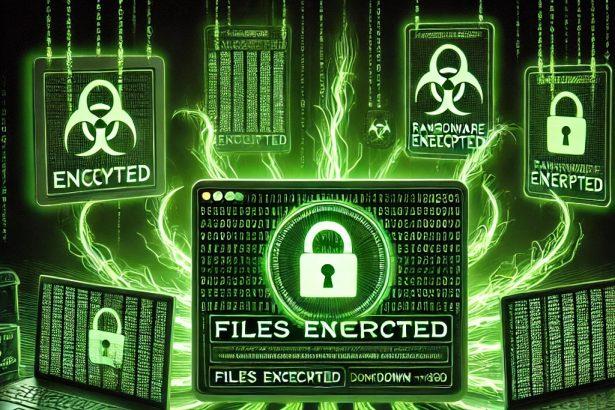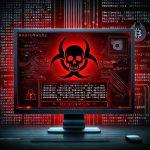Chewbacca is a ransomware-type malware that encrypts users’ files and demands a ransom in exchange for the decryption key. Discovered during a routine analysis of malicious samples submitted to VirusTotal, this threat adds a unique identifier to each encrypted file, followed by the “.chewbacca” extension. For example, a file like photo.jpg becomes photo.jpg.{18348DAC-52AA-1431-7DCB-72284ABD03AA}.chewbacca.
Once encryption is complete, the ransomware delivers its demands through a text file titled README.TXT. This ransom note informs victims that all documents, photos, and databases have been encrypted and urges them to pay for a unique decryption key. While the note offers to decrypt one non-essential file for free as proof, it discourages victims from using third-party tools or engaging intermediaries.
Unfortunately, decryption without the attackers’ key is highly unlikely unless a major flaw is found in the ransomware’s code. Moreover, even paying the ransom doesn’t guarantee file recovery — cybercriminals are under no obligation to provide the decryption tool. Removal of the malware will stop further encryption, but previously locked files will remain inaccessible unless a secure backup exists.
Chewbacca Ransomware – Threat Summary
| Attribute | Details |
|---|---|
| Threat Type | Ransomware, Crypto Virus, File Locker |
| Encrypted File Extension | .{victim’s_ID}.chewbacca |
| Ransom Note File | README.TXT |
| Associated Email Address | chewbacca@cock.li |
| Detection Names | Avast (Win32:RansomX-gen), Combo Cleaner (Dump:Generic.Ransom.BlackLockbit.A.D), ESET-NOD32 (A Variant Of Win32/Filecoder.OOW), Kaspersky (UDS:Trojan-Ransom.Win32.Generic), Microsoft (Ransom:Win32/Beast.YAP!MTB) |
| Symptoms | Files won’t open, new file extensions, ransom note appears on desktop |
| Damage | Data encryption, potential data loss, risk of further malware (e.g. trojans) |
| Distribution Methods | Malicious email attachments, torrents, malicious ads, fake updates |
| Danger Level | High – due to strong encryption and risk of permanent data loss |
Ransom Note Text (README.TXT)
YOUR FILES ARE ENCRYPTED
Your files, documents, photos, databases and other important files are encrypted.
You are not able to decrypt it by yourself! The only method of recovering files is to purchase an unique private key.
Only we can give you this key and only we can recover your files.
To be sure we have the decryptor and it works you can send an email:
chewbacca@cock.li and decrypt one file for free.
But this file should be of not valuable!
Do you really want to restore your files?
Write to email:
chewbacca@cock.li
Attention!
* Do not rename encrypted files.
* Do not try to decrypt your data using third party software, it may cause permanent data loss.
* Decryption of your files with the help of third parties may cause increased price (they add their fee to our) or you can become a victim of a scam.
* Do not contact the intermediary companies. Negotiate on your own. No one but us will be able to return the files to you. As evidence, we will offer to test your files.Manual Ransomware Removal Process
Important: Manual removal is recommended only for experienced users, as incorrect actions can lead to data loss or incomplete removal of the ransomware. If unsure, consider the SpyHunter Removal Method for a guided, automated solution.
Step 1: Disconnect from the Internet
- Immediately disable Wi-Fi or unplug the Ethernet cable to prevent the ransomware from communicating with remote servers.
- This can prevent additional encryption or further infections.
Step 2: Boot into Safe Mode
For Windows Users
- Windows 10/11:
- Press Windows + R, type
msconfig, and press Enter. - Under the Boot tab, select Safe boot and check Network.
- Click Apply, then OK, and restart your PC.
- Press Windows + R, type
- Windows 7/8:
- Restart your PC and press F8 repeatedly before Windows starts.
- Select Safe Mode with Networking and press Enter.
For Mac Users
- Restart your Mac and hold the Shift key immediately after the startup chime.
- Release the key when the Apple logo appears.
- Your Mac will boot in Safe Mode.
Step 3: Identify and Terminate Malicious Processes
Windows
- Open Task Manager by pressing Ctrl + Shift + Esc.
- Look for unusual processes consuming high CPU or memory.
- Right-click on the suspicious process and select End Task.
Mac
- Open Activity Monitor (Finder > Applications > Utilities > Activity Monitor).
- Look for unknown or high-resource-consuming processes.
- Select the suspicious process and click Force Quit.
Step 4: Delete Ransomware Files
Windows
- Open File Explorer and navigate to:
C:\Users\[Your Username]\AppData\LocalC:\Users\[Your Username]\AppData\RoamingC:\Windows\System32
- Identify and delete suspicious files (randomly named or recently modified items).
- Clear temporary files:
- Press Windows + R, type
%temp%, and hit Enter. - Delete all files in the Temp folder.
- Press Windows + R, type
Mac
- Open Finder and select Go > Go to Folder.
- Type
~/Library/Application Supportand check for unfamiliar files or folders. - Remove unknown
.plistfiles from~/Library/LaunchAgents.
Step 5: Remove Ransomware Entries from Registry or System Settings
Windows
- Press Windows + R, type
regedit, and hit Enter. - Navigate to:
HKEY_CURRENT_USER\SoftwareHKEY_LOCAL_MACHINE\Software
- Identify and delete ransomware-related registry entries.
Mac
- Open System Preferences > Users & Groups.
- Select the Login Items tab and remove any unknown startup programs.
- Check
~/Library/Preferencesfor malicious settings.
Step 6: Restore System Using a Backup or Restore Point
Windows
- Press Windows + R, type
rstrui, and press Enter. - Choose a restore point from before the infection and proceed.
Mac
- Restart your Mac and enter macOS Utilities by holding Command + R.
- Select Restore from Time Machine Backup and restore a safe backup.
Step 7: Attempt to Decrypt Files
- Check No More Ransom (www.nomoreransom.org) for available decryption tools.
- If unavailable, restore files from backups.
Automated Ransomware Removal with SpyHunter
If manual removal is too complex or risky, SpyHunter offers a safer, automated method for detecting and removing ransomware.
Step 1: Download SpyHunter
- Get SpyHunter from the official Enigma Software website.
Step 2: Install SpyHunter
- Open the downloaded file (
SpyHunter-Installer.exeor.dmgfor Mac users). - Follow the installation prompts.
- Launch SpyHunter upon completion.
Step 3: Run a Full System Scan
- Click Start Scan Now to detect malware and ransomware.
- Wait for the scan to complete and review detected threats.
Step 4: Remove Detected Ransomware
- Click Fix Threats to remove identified ransomware components.
- SpyHunter will clean your system automatically.
Step 5: SpyHunter’s Custom Malware HelpDesk
- If ransomware persists, use SpyHunter’s Malware HelpDesk for custom malware fixes.
Step 6: Restore Files
- Use backups stored on external drives or cloud storage.
- If no backup is available, check No More Ransom for decryption tools.
Preventing Future Ransomware Attacks
- Keep backups: Use cloud storage or an external hard drive.
- Install a reliable security tool: SpyHunter offers real-time protection against malware.
- Enable Windows Defender or Mac security features for additional protection.
- Avoid phishing emails and unknown attachments.
- Regularly update Windows, macOS, and installed applications.
Final Thoughts
Chewbacca ransomware is part of an ever-growing family of crypto-extortion malware. It mimics the behavior of other ransomware families like Hush, REVRAC, and Chaos-based variants, targeting personal data for financial gain. Its ability to encrypt data beyond reach, combined with the emotional pressure placed on victims via a threatening ransom note, makes it a severe digital threat.
Although tools like antivirus programs can remove the malware itself, they cannot decrypt affected files. This leaves the victims with limited options: rely on a previously secured backup or lose access to their valuable files forever.
If you are still having trouble, consider contacting virtual technical support.




